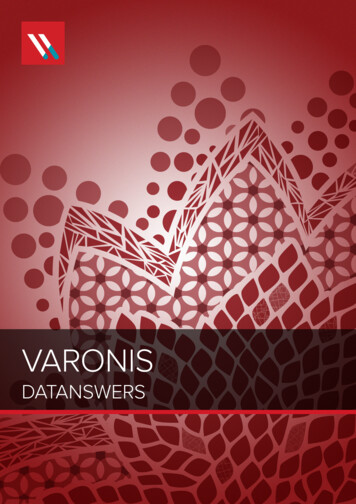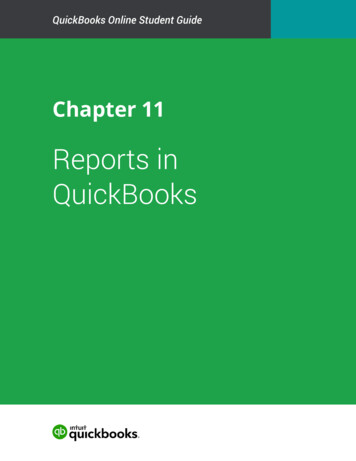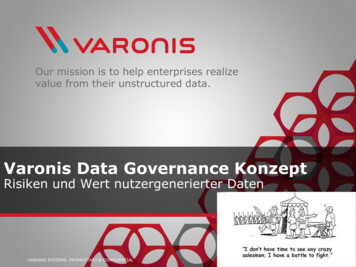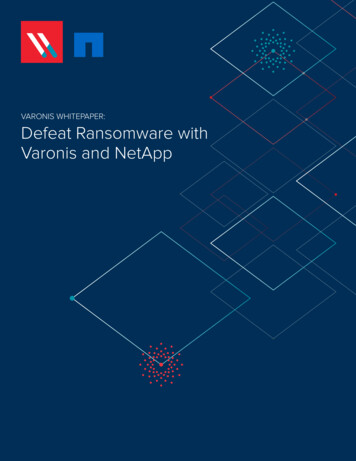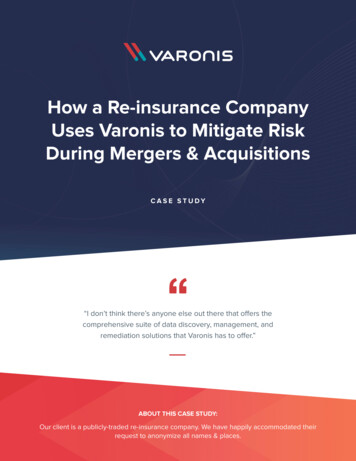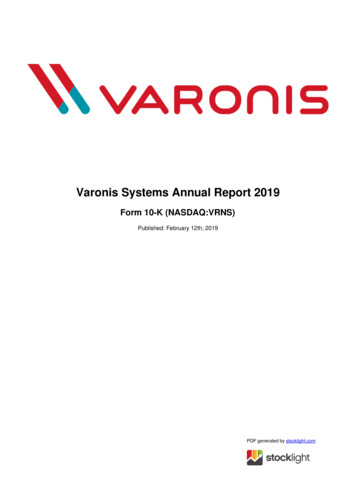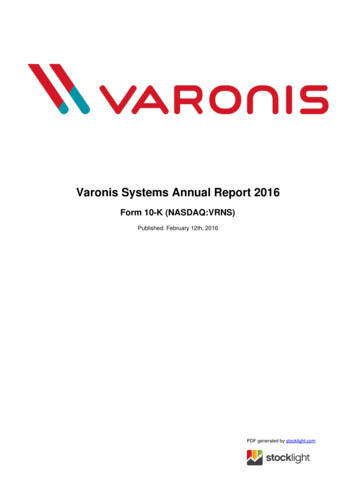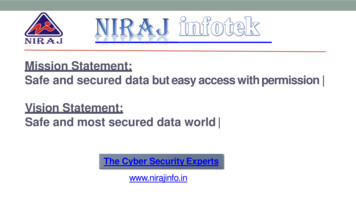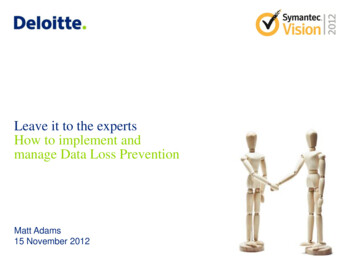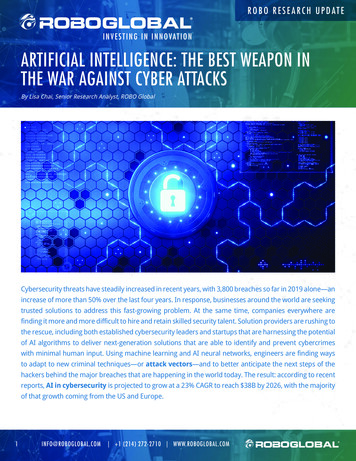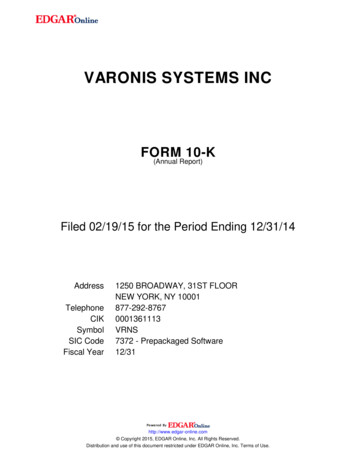
Transcription
VARONIS SYSTEMS INCFORM10-K(Annual Report)Filed 02/19/15 for the Period Ending 12/31/14AddressTelephoneCIKSymbolSIC CodeFiscal Year1250 BROADWAY, 31ST FLOORNEW YORK, NY 10001877-292-87670001361113VRNS7372 - Prepackaged Software12/31http://www.edgar-online.com Copyright 2015, EDGAR Online, Inc. All Rights Reserved.Distribution and use of this document restricted under EDGAR Online, Inc. Terms of Use.
Table of ContentsUNITED STATESSECURITIES AND EXCHANGE COMMISSIONWashington, D.C. 20549FORM 10-K(Mark One) ANNUAL REPORT PURSUANT TO SECTION 13 OR 15(D) OF THE SECURITIES EXCHANGE ACTOF 1934for the Fiscal Year Ended December 31, 2014or TRANSITION REPORT PURSUANT TO SECTION 13 OR 15(D) OF THE SECURITIESEXCHANGE ACT OF 1934for the transition period fromtoCommission file number: 001-36324VARONIS SYSTEMS, INC.(Exact name of registrant as specified in its charter)Delaware57-1222280(State or other jurisdiction of incorporation)(I.R.S. Employer Identification Number)1250 Broadway, 31st FloorNew York, NY 10001(Address of principal executive offices including zip code)Registrant’s telephone number, including area code: (877) 292-8767Securities registered pursuant to Section 12(b) of the Act:Common Stock, par value 0.001 per shareThe NASDAQ Stock Market LLC(Title of class)(Name of exchange on which registered)Securities registered pursuant to Section 12(g) of the Act: NoneIndicate by check mark if the registrant is a well-known seasoned issuer, as defined in Rule 405 of the Securities Act.Yes No Indicate by check mark if the registrant is not required to file reports pursuant to Section 13 or Section 15(d) of the Act.Yes No Indicate by check mark whether the registrant (1) has filed all reports required to be filed by Section 13 or 15(d) of the Securities ExchangeAct of 1934 during the preceding 12 months (or for such shorter period that the registrant was required to file such reports), and (2) has beensubject to such filing requirements for the past 90 days. Yes No
Indicate by check mark whether the registrant has submitted electronically and posted on its corporate Website, if any, every InteractiveData File required to be submitted and posted pursuant to Rule 405 of Regulation S-T (§232.405 of this chapter) during the preceding 12 months(or for such shorter period that the registrant was required to submit and post such files). Yes No Indicate by check mark if disclosure of delinquent filers pursuant to Item 405 of Regulation S-K (§229.405 of this chapter) is not containedherein and will not be contained, to the best of the registrant’s knowledge, in definitive proxy or information statements incorporated byreference in Part III of this Form 10-K or any amendment to this Form 10-K. Indicate by check mark whether the registrant is a large accelerated filer, an accelerated filer, a non-accelerated filer or a smaller reportingcompany. See the definitions of “large accelerated filer,” “accelerated filer,” and “smaller reporting company” in Rule 12b-2 of the ExchangeAct.Large Accelerated Filer Non-accelerated Filer (Do not check if a smaller reporting company)Indicate by check mark whether the registrant is a shell company (as defined in Rule 12b-2 of the Act).Accelerated Filer Smaller reporting company Yes No The aggregate market value of voting stock held by non-affiliates of the registrant as of June 30, 2014 at a closing sale price of 29.01 asreported by the NASDAQ Global Select Market was approximately 273.9 million. Shares of common stock held by each officer and directorand by each person who owns or may be deemed to own 10% or more of the outstanding common stock have been excluded since such personsmay be deemed to be affiliates. This determination of affiliate status is not necessarily a conclusive determination for other purposes.As of February 16, 2015 , the registrant had 24,693,879 shares of common stock, par value 0.001 per share, outstanding.DOCUMENTS INCORPORATED BY REFERENCEPortions of the Registrant’s Proxy Statement to be used in connection with the solicitation of proxies for the Registrant’s 2015 AnnualMeeting of Stockholders are incorporated by reference in Part III of this Annual Report on Form 10-K.
Table of ContentsSpecial Note Regarding Forward-Looking StatementsThis report contains forward-looking statements that involve risks and uncertainties. Our actual results could differ materially from thosediscussed in the forward-looking statements. The statements contained in this report that are not purely historical are forward-looking statementswithin the meaning of Section 27A of the Securities Act of 1933, as amended (the “Securities Act”), and Section 21E of the Securities ExchangeAct of 1934, as amended (the “Exchange Act”). Forward-looking statements are often identified by the use of words such as, but not limited to,“anticipate,” “believe,” “can,” “continue,” “could,” “estimate,” “expect,” “intend,” “may,” “plan,” “project,” “seek,” “should,” “strategy,”“target,” “will,” “would” and similar expressions or variations intended to identify forward-looking statements. These statements are based onthe beliefs and assumptions of our management based on information currently available to management. Such forward-looking statements aresubject to risks, uncertainties and other important factors that could cause actual results and the timing of certain events to differ materially fromfuture results expressed or implied by such forward-looking statements. Factors that could cause or contribute to such differences include, butare not limited to, those identified below and those discussed in the section titled “Risk Factors” included under Part I, Item 1A below.Furthermore, such forward-looking statements speak only as of the date of this report. Except as required by law, we undertake no obligation toupdate any forward-looking statements to reflect events or circumstances after the date of such statements.i
Table of ContentsVARONIS SYSTEMS, INC.ANNUAL REPORT ON FORM 10-KFor The Fiscal Year Ended December 31, 2014TABLE OF CONTENTSPagePART IItem 1Item 1AItem 1BItem 2Item 3Item 4BusinessRisk FactorsUnresolved Staff CommentsPropertiesLegal ProceedingsMine Safety Disclosures1928282828Market for Registrant’s Common Equity, Related Stockholder Matters and Issuer Purchases of Equity SecuritiesSelected Financial DataManagement’s Discussion and Analysis of Financial Condition and Results of OperationsQuantitative and Qualitative Disclosures About Market RiskFinancial Statements and Supplementary DataChanges in and Disagreements with Accountants on Accounting and Financial DisclosureControls and ProceduresOther Information2830314647777777Directors, Executive Officers and Corporate GovernanceExecutive CompensationSecurity Ownership of Certain Beneficial Owners and Management and Related Stockholder MattersCertain Relationships and Related Transactions, and Director IndependencePrincipal Accounting Fees and Services7878787878Exhibits and Financial Statement Schedules79PART IIItem 5Item 6Item 7Item 7AItem 8Item 9Item 9AItem 9BPART IIIItem 10Item 11Item 12Item 13Item 14PART IVItem 15ii
Table of ContentsPART IItem 1.BusinessWe were incorporated under the laws of the State of Delaware on November 3, 2004 and commenced operations on January 1, 2005. Ourprincipal executive offices are located at 1250 Broadway, 31st Floor, New York, NY 10001. For convenience in this report, the terms“Company,” “Varonis,” “we” and “us” may be used to refer to Varonis Systems, Inc. and/or its subsidiaries, except where indicated otherwise.Our telephone number is (877) 292-8767.OverviewWe provide an innovative software platform that allows enterprises to map, analyze, manage and better utilize their unstructured data. Wespecialize in human-generated data, a type of unstructured data that includes an enterprise’s spreadsheets, word processing documents,presentations, audio files, video files, emails, text messages, and any other data created by employees. This data often contains an enterprise’sfinancial information, product plans, strategic initiatives, intellectual property and numerous other forms of vital information. Our MetadataFramework is a proprietary technology platform that extracts critical metadata, or data about data, from an enterprise’s IT infrastructure and usesthis contextual information to map functional relationships among employees, data objects, content and usage. IT and business personnel deployour software for a variety of use cases, including data governance, data security, archiving, file synchronization, enhanced mobile dataaccessibility and information collaboration.In today’s information-based economy, enterprises must share, protect and manage their vital information assets; however, the rapidgrowth in data volume and complexity is making it significantly harder for enterprises to do so. The IDC Study estimates that the amount ofdigital information created and replicated will grow at a compound annual growth rate of 39% from 2012 through 2020 and more than 90% ofthe data created in the next decade will be unstructured data. We believe that unstructured data represents a critical business asset, andenterprises are increasingly seeking ways to maximize the value of this data, while simultaneously ensuring that the data is appropriately securedand managed. Despite the importance of their digital assets, most enterprises have difficulty tracking who has access to select data, who isresponsible for that data, and which employees are accessing, creating, manipulating or deleting it.The revolution in internet search occurred when search engines began to mine internet metadata, such as the links between pages, inaddition to page content, thereby making the internet’s content more usable and consequently more valuable. Similarly, our MetadataFramework creates advanced searchable data structures and provides real-time intelligence about an enterprise’s massive volumes of humangenerated content, to create more accessible, manageable and secure human-generated data.We believe that the technology underlying our Metadata Framework is our primary competitive advantage. The strength of our solution isdriven by several proprietary technologies and methodologies that we have developed, coupled with how we have seamlessly combined theminto our highly versatile Metadata Framework. Our technological advantage stems from us having developed a way to do each of the following: determine which metadata to capture; capture that metadata without imposing any strains or latencies on the enterprise’s computing infrastructure; modify that metadata in a way which makes it comparable and analyzable despite it having originated from disparate IT systems; create supplemental metadata, as needed, when the existing IT infrastructure’s activity logs are not sufficient; decipher the key functional relationships of metadata, the underlying data, and its creators; use those functional relationships to create a graphical depiction, or map, of the data which will endure as enterprises add largevolumes of data to their network and storage resources on a daily basis;1
Table of Contents analyze the data and related metadata utilizing sophisticated algorithms, including cluster analyses and machine learning; and visualize and depict the analyses in an intuitive manner, including simulating contemplated changes and automatically execute tasksthat are normally manually intensive for IT and business personnel.The broad applicability of our technology has resulted in our customers deploying our platform for numerous use cases. These use casesinclude: searchable logs of all human-generated data related activity; centralized visibility into the unstructured data of the enterprise;identification of sensitive data and monitoring its security, ownership and usage, thereby reducing potential exposures; identification of andtracking data ownership; business productivity enhancement through self-service data management; intelligent archiving and migration of data;creation of secure hybrid cloud functionalities; secure search; abnormal activity alerts and identification and security of high-risk data.We believe that the diverse functionalities offered by our platform positions us at the intersection of several powerful trends in the digitaluniverse. The addressable markets for the functionalities delivered by our platform are many and include portions of the markets defined by IDCas storage software, collaborative applications, IT Security (including endpoint security, messaging security and securing and vulnerabilitymanagement), identity and access management, enterprise search, and data integration and access software. IDC estimates that the aggregatetotal spend of these established markets in 2012 was approximately 47 billion. We believe that our comprehensive product offering will attracta meaningful portion of this overall spend, resulting in a multi-billion dollar total addressable market. As we continue to innovate and introducenew products, we expect that the use cases for our solutions will expand, leading to incremental growth in our addressable market opportunity.We sell the vast majority of our products and services to channel partners, including distributors and resellers, which sell to end-usercustomers, which we refer to in this report as our customers. We believe that our sales model, which combines the leverage of a channel salesmodel with our highly trained and professional sales force, has played and will continue to play a major role in our ability to grow and tosuccessfully deliver our unique value proposition for enterprise human-generated data. We target customers of all sizes, in all industries and inall geographies. As of December 31, 2014, we had more than 3,300 customers, spanning leading firms in the financial services, public,healthcare, industrial, energy and utilities, technology, consumer and retail, education and media and entertainment sectors.Size of Our Market OpportunityWe believe that the diverse functionalities offered by our platform position us at the intersection of several powerful trends in the digitalenterprise data universe. We believe that the business intelligence and functionalities delivered by our platform define a new market, and we arenot aware of any third party studies that accurately define our addressable market. According to industry sources, the functionality of oursoftware platform does overlap with portions of markets defined and sized by IDC, including storage software ( 15 billion), collaborativeapplications ( 9 billion), IT Security (including endpoint security, messaging security and securing and vulnerability management— 15 billion),identity and access management ( 4 billion), and data integration and access software ( 4 billion). IDC estimated that the aggregate total spendwithin these established markets in 2012 was approximately 47 billion. We believe that our comprehensive product offering will attract ameaningful portion of this overall spend, resulting in a multi-billion dollar addressable market. As we continue to innovate and introduce newproducts, the use cases for our solutions will expand, leading to incremental growth in our addressable market opportunity.Our TechnologyOur proprietary technology extracts critical information about an enterprise’s stored human-generated data and uses this contextualinformation, or metadata, to create a functional map of an enterprise’s human-generated content. Our Metadata Framework technology has beenarchitected to process large volumes of human-generated data and the related metadata at a massive scale with minimal demands on the existingIT infrastructure. All of our products, except DatAnywhere, utilize our Metadata Framework and a core single codebase, thereby streamliningour product development initiatives.2
Table of ContentsKey Benefits of Our TechnologyComprehensive Solution for Human-Generated Data. Our products enable a broad range of functionality, including data governance,secure search and remote collaboration, secure BYOD implementations and intelligent retention—all from one core technology platform.Moreover, our platform is applicable across all major enterprise platforms (Windows, UNIX/Linux, Intranets and email systems).Fast Time to Value and Low Total Cost of Ownership. Our solutions do not require custom implementations or long deployment cycles.Our platform can be installed and ready for use within hours and allows customers to realize real value within days of implementation. Wedesigned our platform to operate on commodity hardware with standard operating systems, further reducing the cost of ownership of ourproduct.Ease of Use. While we utilize complex data structures and algorithms in our data engine, we abstract that complexity to provide a sleek,intuitive interface. Our software can be accessed through either the local client or a standard web browser and requires limited training, savingon time and cost and making it accessible to the broader set of non-technical users.Highly Scalable and Flexible Data Engine. Our metadata analysis technology is built to be highly flexible and scalable, allowing ourcustomers to analyze vast amounts of human-generated enterprise data. Moreover, our proprietary Metadata Framework was built with amodular architecture, allowing customers to grow into the full capabilities of our solution over time.No Impact on End User Mobile Experience. Our DatAnywhere product was designed to provide enterprises enhanced control of their datawhile simultaneously offering employees all of the functionality, ease of use and ubiquitous accessibility they have come to expect from thirdparty cloud storage services. Our solutions collect metadata with no impact on the collaborative file sharing and email environments. End usermobile experience is maintained while using existing access methods and improved when using file synchronization and mobile access.Our Growth StrategyOur objective is to be the primary vendor to which enterprises turn to analyze, protect and transform into actionable intelligence theirhuman-generated data. The following are key elements of our growth strategy.Extend Our Technological Capabilities Through Innovation. We intend to maintain our high level of investment in product development inorder to enhance existing products to address new use cases and deliver new products. We believe that the flexibility, sophistication and broadapplicability of our Metadata Framework will allow us to use our Metadata Framework as the core of numerous future products built on oursame core technology. Our ability to effectively leverage our research and development resources has enabled us to create a new productdevelopment engine that we believe can proactively identify and solve enterprise needs.Grow Our Customer Base. The unabated rise in unstructured data in enterprises and the ubiquitous reliance on digital collaboration willcontinue to drive demand for data collaboration, governance and retention solutions. We intend to capitalize on this demand by targeting newcustomers, vertical markets and use cases for our solutions. Our solutions address the needs of customers of all sizes ranging from small andmedium businesses to large multinational companies with thousands of employees and petabytes of data.Increase Sales to Existing Customers. We believe significant opportunities exist to further expand relationships with existing customers.Unstructured data growth continues across all the platforms, and enterprises wish to standardize on solutions that help them manage, protect andextract more value from their data wherever it is stored. We will continue to cultivate incremental sales from our existing customers by drivingincreased use of our software within our installed base by expanding footprint and usage. We currently have six products, and as ofDecember 31, 2014, approximately 42% of our customers purchased two or more products. We believe our existing3
Table of Contentscustomer base serves as a strong source of incremental revenues given the broad platform of products we have and the growing volumes andcomplexity of human-generated data our customers have. As we innovate and expand our product offering, we will have an even broader suite ofproducts to offer our customers.Grow Our Sales Force. Growing our salesforce will be essential to achieving our customer base expansion goals. The salesforce and ourapproach to introducing products to the market has been key to our successful growth in the past and will be central to our growth plan in thefuture. Our model focuses on targeting customers of all sizes, industries, and geographies. The ability of our sales teams to support our channelpartners to efficiently identify leads, generate evaluations, and convert them to satisfied customers will continue to impact our ability to grow.We intend to expand our sales capacity by adding headcount throughout our sales and marketing department.Grow Sales from Our Recently Introduced Products. During the past three years, we have introduced three major new products—DatAnswers, DatAnywhere and Data Transport Engine. We believe these products can be a meaningful contributor to our growth and intend todevote significant resources to growing sales of these products.Establish Our Metadata Framework as The Industry Standard. We have worked with several of the leading providers of network attachedstorage, or NAS, hardware, including EMC, NetApp, HP and Hitachi, in order to expand our market reach and deliver enhanced functionality toour customers. We have worked with these vendors to assure compatibility with their NAS product lines. Through the use of applicationprogramming interfaces, or APIs, and other integration work, our solutions also integrate with many providers of solutions in the ecosystem. Wewill continue to selectively pursue such collaborations wherever they advance the strategic goals of the company, thereby expanding our reachand establishing our product user interface as the de facto industry standard when it comes to human-generated enterprise data.Continue International Expansion. We believe there is a significant opportunity for our platform in international markets, encompassingvirtually any enterprise that uses file shares, intranets and email for collaboration. Revenues from outside the United States accounted forapproximately 44% of our revenues in 2014. Europe represented the substantial majority of revenues outside the United States. We believe thatinternational expansion will be a key component of our growth strategy and we will continue to market our products and services overseas.Our ProductsWe offer six products, most of which utilize our core Metadata Framework technology to deliver features and functionality that allowenterprises to fully understand and benefit from the value of their human-generated data. This architecture easily extends through modularfunctionalities giving our clients the flexibility to select the features they require for their business needs and the flexibility to expand their usagesimply by adding a license. DatAdvantage. DatAdvantage, our flagship product, launched in 2006, builds on our Metadata Framework and captures, aggregates,normalizes and analyzes every data access event for every user on Windows and UNIX/Linux servers, storage devices, email systemsand Intranet servers, without requiring native operating system auditing functionalities or impacting performance or storage on filesystems. Through an intuitive graphical interface, DatAdvantage presents insights from massive volumes of human-generated datausing normal computing infrastructure. It is also our presentation layer for IT departments, which provides an interactive map ofrelevant user, group, and data objects, usage and content, facilitating analysis from multiple vectors. IT departments can pinpointareas of interest starting with any metadata object, simulate changes measuring potential impact against historical access patterns,and easily execute changes on all platforms through a unified interface. DataPrivilege. DataPrivilege, also launched in 2006 and designed for use by business unit personnel, provides a self-service webportal that allows users to request access to data necessary for their business functions, and owners to grant access without ITintervention. DataPrivilege also enables IT and business users to make access decisions based on queries, user requests and metadataanalytics information, rather than static IT policies. DataPrivilege provides a presentation layer for business users to reviewaccessibility and usage of their data assets, and grant and revoke access.4
Table of Contents IDU Classification Framework. As the volume of an enterprise’s information grows, enterprises struggle to find and tag differenttypes of sensitive data, such as intellectual property, regulated content including Personally Identifiable Information, and medicalrecords. Furthermore, content by itself does not provide adequate context to determine ownership, relevance, or protectionrequirements. Our IDU Classification Framework, introduced in 2009, identifies and tags data based on criteria set in multiplemetadata dimensions, and provides business and IT personnel with actionable intelligence about this data, including a prioritized listof folders and files containing the most sensitive data and with the most inadequate permissions. For the identified folders and files, italso identifies who has access to that data, who is using it, who owns it, and recommendations for how to effectively limit accesswithout disrupting workflow. Our IDU Classification Framework provides visibility into the content of data across file systems andIntranets sites and combining it with other metadata, including usage and accessibility. Data Transport Engine. We introduced our Data Transport Engine software in 2012 to provide an execution engine that unifies themanipulation of data and metadata, translating business decisions and instructions into technical commands such as data migration orarchiving. Data Transport Engine allows both IT and business personnel to standardize and streamline activities for data managementand retention, from day-to-day maintenance to complex platform and domain migrations and archiving. Our Data Transport Engineensures that data migrations automatically synchronize source and destination data with incremental copying even if the source datais still being used, translates access permissions across platforms and domains and provides reporting capabilities for data migrationstatus. Moreover, it also provides IT personnel the flexibility to schedule recurring migrations to automatically find and move certaintypes of data such as sensitive or stale data, and to perform active migrations, dispositions, and archiving safely and efficiently. DatAnywhere. With the growth of cloud-based file sharing and synchronization services, enterprises increasingly face instanceswhere employees save confidential, proprietary or sensitive company or client data onto third-party data sharing services, either forremote working purposes or to share with external business partners. This practice leads to an enhanced end user mobile experiencebut creates a new, often redundant data store outside of corporate visibility, oversight or control, and poses a security and data lossthreat. We introduced DatAnywhere in 2012 in response to the need by enterprises for a secure and easy-to-use alternative toconsumer cloud-based file sharing solutions. DatAnywhere provides our customers’ employees a modern collaboration, hybrid-cloudexperience using their existing storage infrastructure to leverage existing investments and in house platform expertise, and providesusers this experience using applications on their mobile devices. DatAnywhere allows users to seamlessly collaborate with otherusers that still use the same traditional common internet file system shares via mapped drives or universal naming convention paths.It ensures that the shared data remains on firm file servers and retains the approved access permissions without any need for data tobe moved from existing file shares or migrated to a proprietary repository. DatAnywhere also seamlessly integrates with the existingbackup policies, cache devices, distributed file system, replication and existing data governance and compliance technologies,processes and policies. DatAnswers. As employees continue to generate and store data in numerous enterprise platforms, relevant files they and theircoworkers and predecessors create become harder to find. Unlike the internet, where powerful search engines make relevant webinformation easy to find despite rapid growth, enterprise file systems are frequently not searchable by employees or IT. Thoughenterprise search technologies exist, many enterprises do not own or use them to index human generated data, for several reasons,including performance (the index must be up to date to be useful, requiring continual scanning for new and changed content),security (sensitive files that are not adequately restricted become far easier for the wrong people to find), relevance (when many filescontain the term or terms a searcher is looking for they are not ranked or presented in a way that they are likely to find the right files),and cost (enterprise search technologies require significant, ongoing investments in hardware and software). DatAnswers wasintroduced in 2014 to provide secure, relevant and timely search functionality for human generated data. Capitalizing on theMetadata Framework infrastructure and its analysis of data access events, file system and directory services metadata, DatAnswersindexes files as they are created and changed without requiring continual scanning, filters out results users shouldn’t see based on
VARONIS SYSTEMS, INC. (Exact name of registrant as specified in its chart er) 1250 Broadway, 31st Floor New York, NY 10001 (Address of principal executive offices including z ip code) Registrant s telephone number, including area code: (877) 292-8767 Securities registered pursuant to Section 12(b) of the Act: Securities registered pursuant to Section 12(g) of the Act: None Indicate by check .
